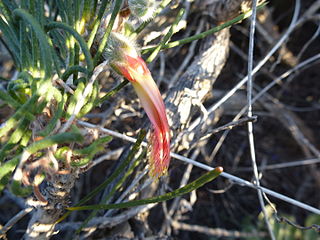
Nicotiana glauca is a species of flowering plant in the tobacco genus Nicotiana of the nightshade family Solanaceae. It is known by the common name tree tobacco. Its leaves are attached to the stalk by petioles, and its leaves and stems are neither pubescent nor sticky like Nicotiana tabacum. It resembles Cestrum parqui but differs in the form of leaves and fusion of the outer floral parts. It grows to heights of more than two meters.

Duboisia is a genus of small perennial shrubs and trees that grow up to 14 metres tall, with extremely light wood and a thick corky bark. There are four species; all occur in Australia, and one also occurs in New Caledonia.

Acacia ligulata is a species of Acacia, a dense shrub widespread in all states of mainland Australia. It is not considered rare or endangered.

Banksia petiolaris is a rare species of flowering plant in the family Proteaceae native to Western Australia, where it is found in sandy soils in the south coastal regions from Munglinup east to Israelite Bay. It was first described by Victorian state botanist Ferdinand von Mueller in 1864, and no subspecies are recognised. B. petiolaris is one of several closely related species that will all grow as prostrate shrubs, with horizontal stems and thick, leathery upright leaves. Those of this species can be viable for up to 13 years—the longest-lived of any flowering plant recorded. It bears yellow cylindrical flower spikes, known as inflorescences, up to 16 cm high in spring. As the spikes age, they turn grey and develop up to 20 woody seed pods, known as follicles, each.

Banksia blechnifolia is a species of flowering plant in the genus Banksia found in Western Australia. It was first described by Victorian state botanist Ferdinand von Mueller in 1864, and no subspecies are recognised. It gained its specific name as its leaves are reminiscent of a fern (Blechnum). B. blechnifolia is one of several closely related species that grow as prostrate shrubs, with horizontal stems and leathery, upright leaves. The red-brown flower spikes, known as inflorescences, are up to 20 centimetres (8 in) high and appear from September to November in the Australian spring. As the spikes age, each turns grey and develops as many as 25 woody seed pods, known as follicles.
Pituri is a mixture of leaves and wood ash traditionally chewed as a stimulant by Aboriginal Australians widely across the continent. Leaves are gathered from any of several species of native tobacco (Nicotiana) or from at least one distinct population of the species Duboisia hopwoodii. Various species of Acacia, Grevillea and Eucalyptus are burned to produce the ash. The term "pituri" may also refer to the plants from which the leaves are gathered or from which the ash is made. Some authors use the term to refer only to the plant Duboisia hopwoodii and its leaves and any chewing mixture containing its leaves.

Hakea orthorrhyncha, commonly known as bird beak hakea, is a shrub which is endemic to the Murchison River area of Western Australia.

Banksia armata var. armata is a variety of shrub that is endemic to Western Australia. It differs from the other variety in having a lignotuber, narrower leaves with more sides lobes and shorter flowers. It is also usually a shorter plant.

Acacia beauverdiana, commonly known as pukkati, is a member of genus Acacia that is native to Western Australia. It is a perennial tree 1 to 8 metres tall with multiple stems. It has yellow flowers and it blooms from July to October. It is native to Western Australia.

Howittia is a genus of plant containing the single species, Howittia trilocularis, commonly known as blue howittia, and is endemic to Australia. It is a tall shrub found growing in shaded valleys and on rainforest edges, it has hairy leaves and single, purple flowers.

Livistona mariae, also known as the central Australian or red cabbage palm, is a species of flowering plant in the family Arecaceae.

Stirlingia simplex is a plant endemic to Western Australia.

Grevillea pimeleoides is a shrub which is endemic to the south west region of Western Australia.

Grevillea stenomera, commonly known as lace net grevillea, is a shrub in the family Proteaceae. It is endemic to Western Australia, occurring between Kalbarri and Tamala.

Adenanthos detmoldii, commonly known as Scott River jugflower or yellow jugflower, is a species of shrub in the family Proteaceae. It is endemic to the south-west of Western Australia.

Calothamnus chrysanthereus , commonly known as claw flower is a plant in the myrtle family, Myrtaceae and is endemic to the south-west of Western Australia. It is an erect shrub with needle-shaped leaves crowded on the ends of the branches and bright red flowers in spring.

Eucalyptus bigalerita, commonly known as the northern salmon gum, Adelaide River white gum, or poplar gum is a species of tree that is endemic to north-western Australia. It has smooth bark, large triangular to more or less round adult leaves, flower buds in groups of seven, white flowers and conical to hemispherical fruit.

Nornicotine is an alkaloid found in various plants including Nicotiana, the tobacco plant. It is chemically similar to nicotine, but does not contain a methyl group.

Liparis habenarina, commonly known as the common sphinx orchid or common hobgoblin orchid, is a plant in the orchid family and is endemic to Australia. It is a deciduous, terrestrial orchid with two or three egg-shaped leaves and between eight and twenty-two brownish to purplish flowers with their lateral sepals joined at the base. It grows in the understorey of near-coastal forests.

Hakea rostrata, common name beaked hakea, is a flowering plant in the family Proteaceae, native to South Australia and Victoria.



















